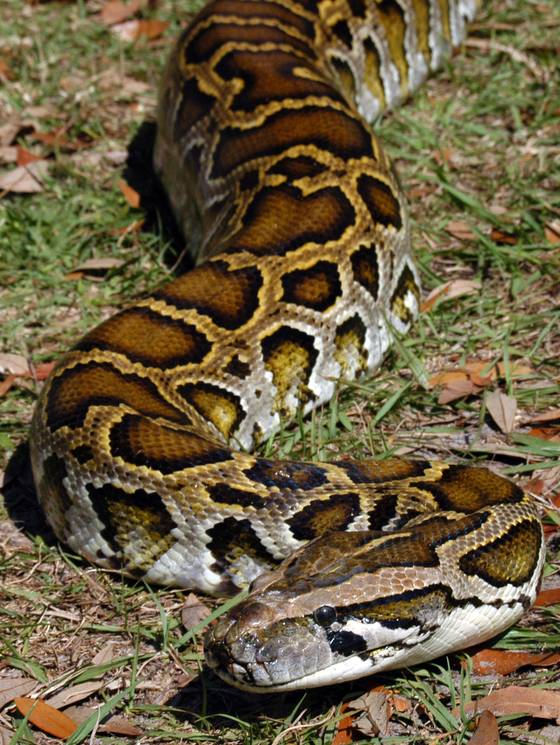Results 1 to 1 of 1
Thread Information
Users Browsing this Thread
There are currently 1 users browsing this thread. (0 members and 1 guests)
-
12-20-2012, 07:25 PM #1
Fla. hunt to target exotic, invasive pythons
Fla. hunt to target exotic, invasive pythons
Karl Etters, Tallahassee (Fla.) Democrat6:07p.m. EST December 20, 2012
You've heard of alligator wrestlers; now meet a new breed of reptile hunter.

Hunters will target Burmese pythons in the Florida Everglades during the Florida Fish and Wildlife Conservation Commission's first ever Python Challenge, starting in January.(Photo: Tim Donovan, Florida Fish and Wildlife Conservation Commission)
TALLAHASSEE, Fla. — From California to New Hampshire; Crawfordville, Fla.; to Miami, more than 200 people from 24 states will descend on South Florida in January to try to nab a Burmese python.
With help from the Florida Fish and Wildlife Conservation Commission and the University of Florida, they will have a chance to help loosen the 30-year grip of the species on the Everglades.
The 2013 Python Challenge, the trademarked brainchild of the state, is aimed at capturing as many Burmese pythons as possible and registration is still open.
Florida already spends $300,000 to $350,000 a year on removal of the snakes that are native to southeast Asia.
STORY: Huge Burmese python caught in Florida Everglades
STORY: Pythons have stranglehold on Everglades ecosystem
State wildlife officials also want to raise awareness about a species that can grow to more than 20 feet and poses a threat to the health of the delicate ecosystem found in the Everglades.
Participants will meet Feb. 16 at Zoo Miami after a monthlong competition beginning Jan. 12 to learn who won prizes for the most pythons harvested and longest snake. Top winners will receive $1,500 and $1,000, respectively.
The python population in Florida has been estimated at more than 100,000, but Fish and Wildlife spokeswoman Carli Segelson said counting the snakes is difficult because of their camouflage and the vastness of their territory.
Though theories differ, Segelson and others speculate that the snakes escaped during Hurricane Andrew in 1992 when high winds destroyed a wholesaler's building.
"It's difficult to pinpoint exactly where all of the snakes come from," Segelson said. "But it is believed that some of the snakes potentially escaped from pet stores or breeders."
Pet owners also have released snakes when they became too difficult to manage.
But in the wild, the pythons have thrived, in part because they have no natural predators. Now the state is introducing them.
John Calderazzo of Fort Collins, Colo., will be making the trek. The English professor at Colorado State University is hunting not only snakes but material for his nonfiction writing.
"I'm really concerned about what's happening with the Everglades," Calderazzo said. "It seems like a petri dish for any exotic animals."




Powered by Leaflet — Terms & Feedback
Florida Everglades
Calderazzo lived in Florida in the 1960s and said the invasive species fits menacingly into the bigger picture of the environment.
"I see the python thing as a kind of example as something we have let loose on the world and allowed it to multiply before we've had a chance to know what its implications are," said Calderazzo, adding that "pythons are the reptile version of kudzu," an invasive vine native to Japan and southeast China.
Earlier this year, scientists in the Everglades captured the largest Burmese python ever recorded in Florida, measuring 17.7 feet. The female held 87 eggs, another record and the true concern of wildlife officials.
Diane Hirth, a habitat and species conservation specialist with Fish and Wildlife Conservation, said the first documented nest found in the Everglades in 2006 was a sign the snakes were thriving in the tropical climate.
"If they're there and they're breeding, then that's one too many," Hirth said.
They feed on small mammals, birds and even the occasional alligator, according to the National Park Service, which oversees more than half of the 4,000 square miles of the Everglades.
Anyone can participate in the snake hunt, but those who apply for a python permit will be allowed to hunt outside of four Everglades wildlife management areas that are designated as hunting grounds for the competition.
Along with a $25 application fee, those younger than 18 are required to have a Florida hunting license.
The Python Challenge is the latest effort to control the population.
In 2010, then-Gov. Charlie Christ agreed with the Florida Legislature to prohibit the possession, import, sale or breeding of the Nile monitor lizard and five species of non-native snakes, including the Burmese python. The legislation was prompted, in part, by the July 2009 death of a 2-year-old Sumter County girl killed because a family's pet python escaped its cage.
In the Everglades, pythons threaten endangered species like the Key Largo wood rat and the wood stork.
"These animals are obviously going to compete with other animals for food, and they are also going to consume native wildlife," Segelson said.
About Burmese pythons
• They are different from other snakes because they have two functioning lungs and small, visible vestigial hind limbs that play a role in courtship.
• Pythons kill their prey by constriction, not venom.
• The snakes can reach up to 25 feet in length and close to 200 pounds.
• Pythons can stay submerged for more than 30 minutes.
• Pythons have more than 400 sets of ribs.
• Pythons can live for 30 years in the wild.
http://www.usatoday.com/story/news/nation/2012/12/20/florida-python-hunt/1783033/NO AMNESTY
Don't reward the criminal actions of millions of illegal aliens by giving them citizenship.
Sign in and post comments here.
Please support our fight against illegal immigration by joining ALIPAC's email alerts here https://eepurl.com/cktGTn


 LinkBack URL
LinkBack URL About LinkBacks
About LinkBacks




 Reply With Quote
Reply With Quote


Watch: Paul, Hawley Torch Mayorkas To His Face On Laken Riley's...
04-19-2024, 02:32 PM in illegal immigration News Stories & Reports